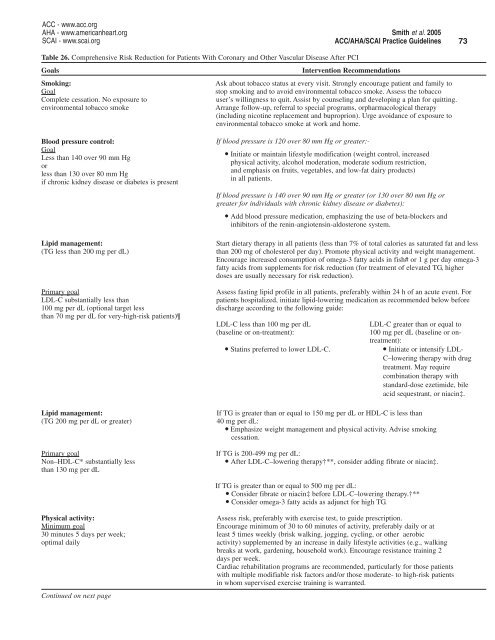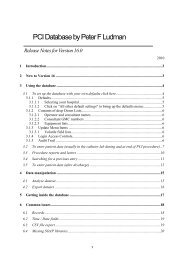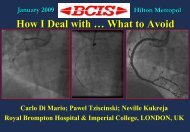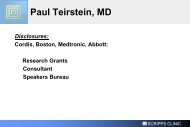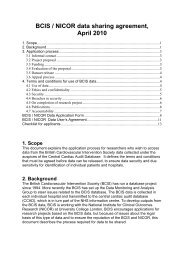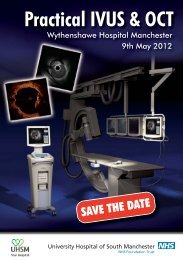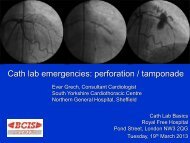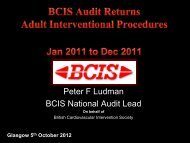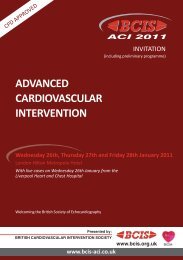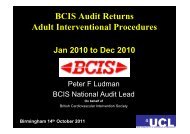Recommendations
ACC/AHA/SCAI PCI Guidelines - British Cardiovascular Intervention ...
ACC/AHA/SCAI PCI Guidelines - British Cardiovascular Intervention ...
- No tags were found...
You also want an ePaper? Increase the reach of your titles
YUMPU automatically turns print PDFs into web optimized ePapers that Google loves.
ACC - www.acc.org<br />
AHA - www.americanheart.org<br />
SCAI - www.scai.org<br />
Smith et al. 2005<br />
ACC/AHA/SCAI Practice Guidelines<br />
73<br />
Table 26. Comprehensive Risk Reduction for Patients With Coronary and Other Vascular Disease After PCI<br />
Goals<br />
Intervention <strong>Recommendations</strong><br />
Smoking:<br />
Ask about tobacco status at every visit. Strongly encourage patient and family to<br />
Goal<br />
stop smoking and to avoid environmental tobacco smoke. Assess the tobacco<br />
Complete cessation. No exposure to<br />
user’s willingness to quit. Assist by counseling and developing a plan for quitting.<br />
environmental tobacco smoke<br />
Arrange follow-up, referral to special programs, orpharmacological therapy<br />
(including nicotine replacement and buproprion). Urge avoidance of exposure to<br />
environmental tobacco smoke at work and home.<br />
Blood pressure control:<br />
Goal<br />
Less than 140 over 90 mm Hg<br />
or<br />
less than 130 over 80 mm Hg<br />
if chronic kidney disease or diabetes is present<br />
Lipid management:<br />
(TG less than 200 mg per dL)<br />
Primary goal<br />
LDL-C substantially less than<br />
100 mg per dL (optional target less<br />
than 70 mg per dL for very-high-risk patients)<br />
Lipid management:<br />
(TG 200 mg per dL or greater)<br />
Primary goal<br />
Non–HDL-C* substantially less<br />
than 130 mg per dL<br />
If blood pressure is 120 over 80 mm Hg or greater:·<br />
• Initiate or maintain lifestyle modification (weight control, increased<br />
physical activity, alcohol moderation, moderate sodium restriction,<br />
and emphasis on fruits, vegetables, and low-fat dairy products)<br />
in all patients.<br />
If blood pressure is 140 over 90 mm Hg or greater (or 130 over 80 mm Hg or<br />
greater for individuals with chronic kidney disease or diabetes):<br />
• Add blood pressure medication, emphasizing the use of beta-blockers and<br />
inhibitors of the renin-angiotensin-aldosterone system.<br />
Start dietary therapy in all patients (less than 7% of total calories as saturated fat and less<br />
than 200 mg of cholesterol per day). Promote physical activity and weight management.<br />
Encourage increased consumption of omega-3 fatty acids in fish# or 1 g per day omega-3<br />
fatty acids from supplements for risk reduction (for treatment of elevated TG, higher<br />
doses are usually necessary for risk reduction).<br />
Assess fasting lipid profile in all patients, preferably within 24 h of an acute event. For<br />
patients hospitalized, initiate lipid-lowering medication as recommended below before<br />
discharge according to the following guide:<br />
LDL-C less than 100 mg per dL<br />
(baseline or on-treatment):<br />
• Statins preferred to lower LDL-C.<br />
LDL-C greater than or equal to<br />
100 mg per dL (baseline or ontreatment):<br />
• Initiate or intensify LDL-<br />
C–lowering therapy with drug<br />
treatment. May require<br />
combination therapy with<br />
standard-dose ezetimide, bile<br />
acid sequestrant, or niacin‡.<br />
If TG is greater than or equal to 150 mg per dL or HDL-C is less than<br />
40 mg per dL:<br />
• Emphasize weight management and physical activity. Advise smoking<br />
cessation.<br />
If TG is 200-499 mg per dL:<br />
• After LDL-C–lowering therapy†**, consider adding fibrate or niacin‡.<br />
If TG is greater than or equal to 500 mg per dL:<br />
• Consider fibrate or niacin‡ before LDL-C–lowering therapy.†**<br />
• Consider omega-3 fatty acids as adjunct for high TG.<br />
Physical activity:<br />
Assess risk, preferably with exercise test, to guide prescription.<br />
Minimum goal<br />
Encourage minimum of 30 to 60 minutes of activity, preferably daily or at<br />
30 minutes 5 days per week; least 5 times weekly (brisk walking, jogging, cycling, or other aerobic<br />
optimal daily<br />
activity) supplemented by an increase in daily lifestyle activities (e.g., walking<br />
breaks at work, gardening, household work). Encourage resistance training 2<br />
days per week.<br />
Cardiac rehabilitation programs are recommended, particularly for those patients<br />
with multiple modifiable risk factors and/or those moderate- to high-risk patients<br />
in whom supervised exercise training is warranted.<br />
Continued on next page


